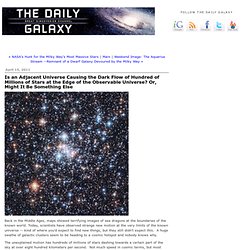

Sirius.
Biggest void in universe may explain cosmic cold spot - space - 03 July 2014. Mystery of cosmic rays' origin finally solved - physics-math - 14 February 2013. Video: Stellar cataclysm The protons that constantly smack into Earth's atmosphere at near the speed of light get their huge energies from exploding stars.

At least that's what physicists and astronomers had long suspected, but direct evidence for the idea has been difficult to come by – until now. Cosmic rays are any charged particles arriving at Earth from space. Nearly all of them are protons, and some have been accelerated to speeds higher than any achieved by a particle accelerator on Earth. Although we have known about cosmic rays since 1912, their origins have remained a puzzle. Hints of lightweight dark matter get even stronger - space - 10 May 2013. A strange light is shining near the centre of the Milky Way, and evidence is mounting that it is the spark of lightweight dark matter meeting a violent end.

At the same time, a suite of sensitive detectors deep underground is seeing hints of similar particles. Dark matter is thought to make up roughly 80 per cent of the matter in the universe. But aside from its gravitational tug on regular matter, the substance has proven tough to detect, and many of its fundamental properties remain unknown. 1st Dark Matter Bridge Discovered Linking Two Galaxy Clusters. A ‘finger’ of the Universe’s dark-matter skeleton, which ultimately dictates where galaxies form, has been observed for the first time bridging the galaxy clusters Abell 222 and Abell 223 2.7 billion light-years away by an international team of astrophysicists using a technique that could eventually help astrophysicists to understand the structure of the Universe and identify what makes up the mysterious invisible substance known as dark matter.

"Dark matter really governs structure formation," said study leader Joerg Dietrich, an astrophysicist at the University Observatory Munich in Germany. 10 Astounding Examples of Pareidolia In Outer Space. Gamma-ray burst blasted Earth in 8th century. An artist's impression of a black hole.

Credit: NASA E/PO, Sonoma State University, Aurore Simonnet. Mystery of Vanishing Dwarf Galaxies Explained? Some dwarf galaxies in the early universe travelled so fast that their gas was stripped from them, according to a new computer simulation.

This cosmic vanishing act could help explain a long-standing mystery: astronomers observe fewer dwarf galaxies in the "Local Group" — the collection of galaxies near the Milky Way — than what models of the universe's formation predict. But if these galaxies are losing gas, that could explain why they don't appear as plentiful as they should. Because these dwarf galaxies were so small when they formed, they don't have large reserves of gas to begin with. Stripping any gas away would leave these galaxies so small and dim that they would be all but invisible from Earth. Largest ever yellow star is 1300 times bigger than sun - space - 12 March 2014.
Pillars of creation built by big stellar bubble - space - 26 June 2014. Video: Stellar bubble creates 'pillars of creation' Building a towering cosmic icon may be as easy as blowing bubbles.

"Will Observe Unique Signature Coming from Direction of Cygnus" Physicists and biologists plan to build a dark matter detector out of DNA that will outperform anything available today, Technology Review Physics arXiv Blog reports.

Mystery Intergalactic Radio Bursts Detected. Astronomers were on a celestial fishing expedition for pulsing neutron stars and other radio bursts when they found something unexpected in archived sky sweeps conducted by the Parkes radio telescope in New South Wales, Australia.

The powerful signal, which lasted for just milliseconds, could have been a fluke, but then the team found three more equally energetic transient flashes all far removed from the galactic plane and coming from different points in the sky. Analysis later indicated that, unlike most cosmic radio signals that originate in the Milky Way or a nearby neighbor galaxy, these four seem to have come from beyond. PHOTOS: Cosmic Hotshots from Keck Observatory Whatever triggered the bursts has come and gone.
The signals, detected between February 2011 and January 2012, were one-time events so little follow-up work can be done. Is an Adjacent Universe Causing the Dark Flow of Hundred of Millions of Stars at the Edge of the Observable Universe? Or, Might It Be Something Else. Back in the Middle Ages, maps showed terrifying images of sea dragons at the boundaries of the known world.

Today, scientists have observed strange new motion at the very limits of the known universe -- kind of where you'd expect to find new things, but they still didn't expect this. NASA's Hubble Finds Telltale Fireball After Gamma Ray Burst - Business News. August 3, 2013 WASHINGTON, Aug. 3, 2013 /PRNewswire/ — NASA’s Hubble Space Telescope recently provided the strongest evidence yet that short-duration gamma ray bursts are produced by the merger of two small, super-dense stellar objects.

(Logo: ) The evidence is in the detection of a new kind of stellar blast called a kilonova, which results from the energy released when a pair of compact objects crash together. The 6 Most Bizarre Things Ever Discovered in Space. Humanity has been looking out into space for thousands of years, and the most important thing we've discovered over that time is that everything is crazy weird out there, and it just keeps getting weirder. Here are some of the more baffling and often terrifying things that astronomers have found in recent years. #6. God's Liquor Cabinet Getty If anything is going to replenish the public's waning interest in space exploration, it's probably this: Below is a photo of Sagittarius B2, a huge cloud a few million times the mass of our sun, floating around near the center of our galaxy.
Via ESOJesus is a wine lover, but God has distinctly trashier tastes. No, really. Not only did God apparently decide to "Irish up" the Milky Way, but this also represents the next best thing to finding life outside our world. . #5. Gravity does some weird things to the universe, and we don't just mean scary things like galaxy-swallowing black holes. Galaxies get up close and personal: Collisions in young galaxy cluster. The VLT Survey Telescope (VST) at ESO's Paranal Observatory in Chile has imaged a fascinating collection of interacting galaxies in the Hercules galaxy cluster. The sharpness of the new picture, and the hundreds of galaxies captured in great detail in less than three hours of observations, attest to the great power of the VST and its huge camera OmegaCAM to explore the nearby Universe. The Hercules galaxy cluster (also known as Abell 2151) lies about 500 million light-years away in the constellation of Hercules.
It is unlike other nearby galactic assemblies in many ways. As well as being rather irregular in shape, it contains a wide variety of galaxy types, particularly young, star-forming spiral galaxies, and there are no giant elliptical galaxies in sight. Rare Monster Galaxy 10-Times Diameter of the Milky Way. Viewing the core is like seeing a city with no center, just houses sprinkled across a vast landscape. Captured by Hubble and Spitzer Space Observatories. Massive "Missing-Link" Galaxy Discovered. Largest Ever Water Reservoir Discovered in Space. Giant clouds of lead glimpsed on distant dwarf stars - physics-math - 01 August 2013. Astronomers Discover Two Heavy Metal Stars. Cosmic collisions spin stellar corpses into gold - space - 17 July 2013.
Stars are hot, right? Not this star. Astronomers have found the coolest star – temperature-wise, that is – although some would argue it should not be called a star. 5 Awesome Stars You Won't Believe Science Class Left Out. Stars are science we used to pray to. Medioimages/Photodisc/Photodisc/Getty Images"I am the alpha and the omega, and the alpha is 1/137. The omega is useful when making iPads. " Gravity draws things together, compressing light elements until they undergo fusion and start glowing. Universe's highest electric current found - space - 21 June 2011.
A COSMIC jet 2 billion light years away is carrying the highest electric current ever seen: 1018 amps, equivalent to a trillion bolts of lightning. The Detailed Universe: This will Blow Your Mind. New Hubble Data Says It's Close, But Not Older than the Universe. Star Size Comparison HD. Will Betelgeuse really become a second sun in 2012? When Galaxies Collide: Photos of Great Galactic Crashes.